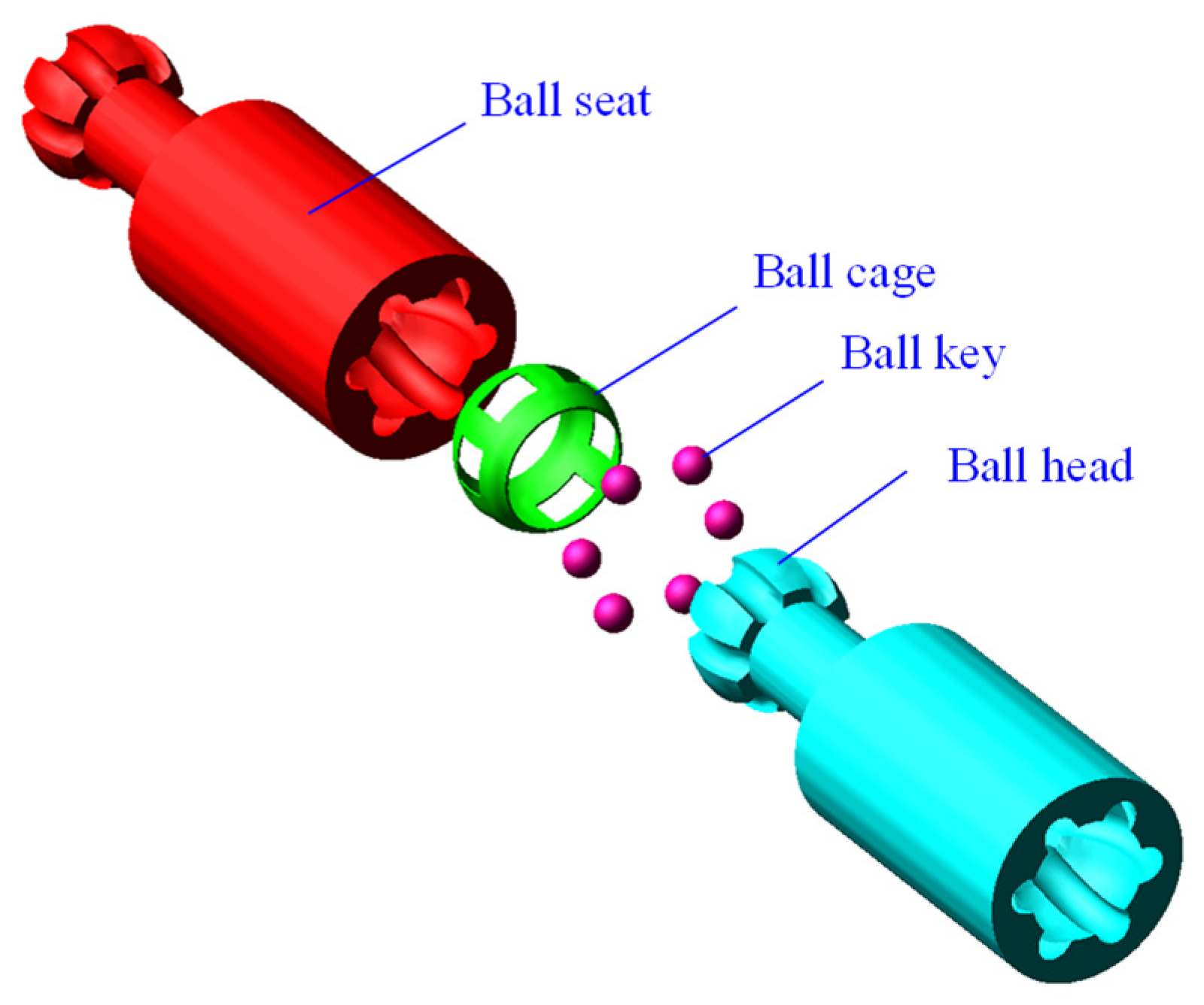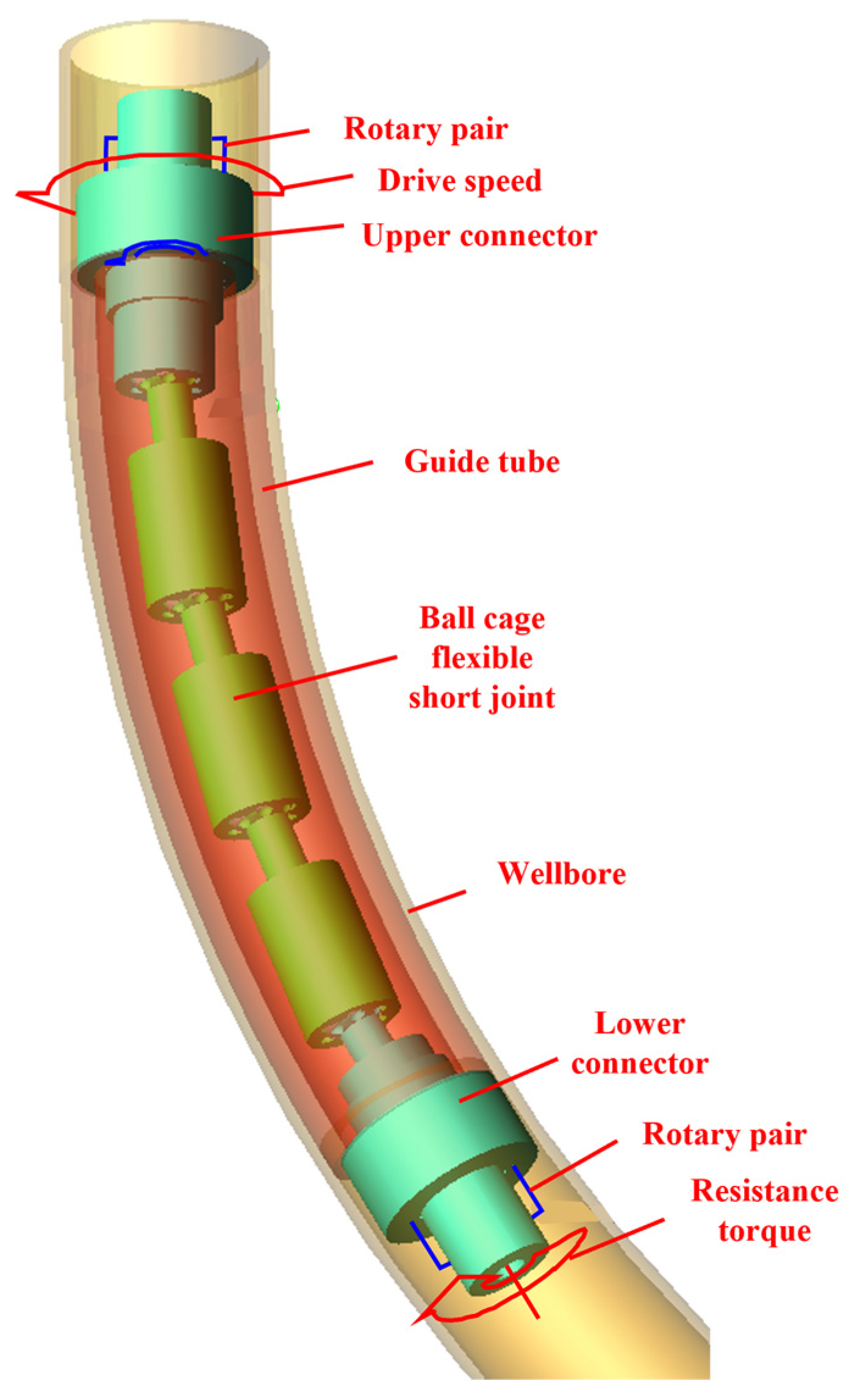Research on Parameter Design Method and Motion Characteristics of a Ball Cage Flexible Joint
Abstract
:1. Introduction
2. Design Parameters of the Ball Cage Flexible Joint
2.1. The Length of the Flexible Joint
2.2. The Diameter of the Ball Key
- (1)
- Squeeze strength
- (2)
- Shear strength
- (3)
- Geometric coordination relation
2.3. Ball Cage Size
- (1)
- Inner and outer spherical diameter of ball cage
- (2)
- Cage width
- (3)
- Window width
- (4)
- Window length
2.4. Parameters of the Ball Cage Flexible Joint
3. Motion Characteristics of the Ball Cage Flexible Joint
3.1. Contact Force of the Ball Key
3.2. Isokinetic Characteristics
3.3. Transfer Efficiency
3.4. Deflection Torque
4. Optimization of the Ball Cage Flexible Joint
5. Conclusions
- (1)
- The new ball cage flexible joint has the characteristics of good constant velocity, large deflection angle, and low energy loss; therefore, it is suitable for field popularization.
- (2)
- The transfer efficiency of the flexible joint was 89.8%, and the power loss rate was only 0.102%, which indicates that the ball cage flexible joint has high working efficiency.
- (3)
- The diameters of the ball seat, ball head, and ball key are the main parameters that affect the ball cage flexible joint tool performance. Through orthogonal tests, the optimal values of the ball seat diameter, ball head diameter, and ball key diameter were 80 mm, 62 mm, and 16 mm, respectively.
- (4)
- The ball key diameter is the main factor determining the flexible joint internal contact force. In the process of rotary drilling, the contact force of the ball key changed periodically, and the contact force of the bending deflection of the inner ball key was greater than the contact force of outer.
Author Contributions
Funding
Data Availability Statement
Conflicts of Interest
References
- Hill, G.J.; Smith, H., Jr.; Schnitker, M.W.; Beatty, G.E. Flexible Drill String Member Especially for Use in Directional Drilling. US Patent US07/111222, 14 March 1989. [Google Scholar]
- Luo, M.; Xu, T.T.; Jiang, J.; Chi, X.; Wang, J.; Xue, S. Two-layer Contact Nonlinear Mechanical Analysis of Flexible Drilling Tool in The Wellbore. Comput. Model. Eng. Sci. 2020, 123, 75–100. [Google Scholar] [CrossRef]
- Warren, T.M.; Winters, W.J.; Mount, H.B.; Mason, K.L. Short-Radius Lateral Drilling System. J. Pet. Technol. 1993, 45, 108–115. [Google Scholar] [CrossRef]
- Bauchau, O.A.; Han, S. Flexible joints in structural and multibody dynamics. Mech. Sci. 2013, 4, 65–77. [Google Scholar] [CrossRef]
- Lara-Molina, F.A.; Dumur, D.; Takano, K.A. Multi-objective optimal design of flexible-joint parallel robot. Eng. Comput. 2018, 35, 2775–2801. [Google Scholar] [CrossRef]
- Santos, C.; Pesce, C.P. An alternative strategy for offshore flexible pipes finite element analysis. Mar. Struct. 2019, 65, 376–416. [Google Scholar] [CrossRef]
- Bachynski, E.E.; Thys, M.; Dadmarzi, F.H. Observations from hydrodynamic testing of a flexible, large-diameter monopile in irregular waves. J. Phys. Conf. Ser. 2020, 1669, 1–10. [Google Scholar] [CrossRef]
- Swaminathan, P.; Narayana, G.K. Design and development of a gauging system for constant velocity ball-cage component of constant velocity joint assembly. Proc. Inst. Mech. Eng. Part B J. Eng. Manuf. 2016, 230, 1169–1174. [Google Scholar] [CrossRef]
- Baiceanu, M.; Flores, P.; Oprisan, C.; Olaru, D. Study of the Contact Force Model on the Dynamic Response of a Four-Bar Mechanism with Clearance Joints. In New Trends in Mechanism and Machine Science; Springer: Cham, Switzerland, 2013; Volume 7, pp. 541–548. [Google Scholar]
- Sugiura, H.; Matsunaga, T. Thrust Force Analysis of Tripod Constant Velocity Joint Using Multibody Model (D & D 2008). Trans. Jpn. Soc. Mech. Eng. Ser. C 2009, 75, 1457–1464. [Google Scholar]
- Kimata, K.; Nagatani, H.; Imoto, M.; Kohara, T. Numerical Analyses and Experiments on the Characteristics of Ball-Type Constant-Velocity Joints. JSME Int. J. 2005, 47, 746–754. [Google Scholar] [CrossRef] [Green Version]
- Berjoza, D.; Pirs, V.; Jurgena, I.; Laceklis-Bertmanis, J. Energy use efficiency of electric automobile depending on transmission gear ratio. In Proceedings of the 17th International Scientific Conference Engineering for Rural Development, Jelgava, Latvia, 23–25 June 2018; pp. 2023–2029. [Google Scholar]
- Mondragon-Parra, E.; Ambrose, G. Influence of Grease in Mechanical Efficiency of Constant Velocity Joints. In Proceedings of the Sae World Congress & Exhibition, Detroit, MI, USA, 12–14 April 2016; Volume 1, pp. 1132–1138. [Google Scholar]
- Feng, H.; Yin, Z.; Shangguan, W.B.; Li, X.; Luo, Y. Analysis and optimization for contact forces and transmission efficiency of an automotive ball joint. Proc. Inst. Mech. Eng. Part D J. Automob. Eng. 2020, 234, 3207–3223. [Google Scholar] [CrossRef]
- Nogi, T.; Maniwa, K.; Natsuoka, N. A Dynamic Analysis of Cage Instability in Ball Bearings. J. Tribol. Transsactions ASME 2017, 140, 1–23. [Google Scholar] [CrossRef]
- Choe, B.; Lee, J.; Jeon, D.; Lee, Y. Experimental study on dynamic behavior of ball bearing cage in cryogenic environments, Part I: Effects of cage guidance and pocket clearances. Mech. Syst. Signal Processing 2019, 115, 545–569. [Google Scholar] [CrossRef]
- Choe, B.; Lee, J.; Jeon, D.; Lee, Y. Numerical Study of Cage Dynamics Focused on Hydrodynamic Effects of Guidance Land Clearances for Different Ball-Pocket Clearances in Cryogenic Environments. J. Eng. Gas Turbines Power Trans. ASME 2018, 140, 1–11. [Google Scholar] [CrossRef]
- Qi, Z.H. Kinematic Analysis and Simulation of the Steel Balls for Rzeppa Constant Velocity Joint. J. Mech. Eng. 2012, 48, 147–153. [Google Scholar] [CrossRef]
- Yamamoto, T.; Matsuda, T.; Okano, N. Efficiency of Constant Velocity Universal Joints. In Proceedings of the International Congress and Exposition, Taejon, Korea, 7 August–7 November 1993; pp. 129–139. [Google Scholar]
- Tang, S.Q.; Yang, D.Y.; Bai, Q.Q. Orthogonal Testing Optimum Design in Radial Electrodynamic Magnetic Bearings. Appl. Mech. Mater. 2013, 397–400, 779–782. [Google Scholar] [CrossRef]
- Chang, Z.; Jia, Q.; Yuan, X.; Chen, Y. Optimization of the grinding process to improve the surface integrity of bearing raceways. Int. J. Adv. Manuf. Technol. 2017, 91, 4243–4352. [Google Scholar] [CrossRef]
- Wu, S.; Zhao, Y.; Li, W.; Liu, W.; Wu, Y.; Liu, F. Optimization of process parameters for thermal shock resistance and thermal barrier effects of 8YSZ thermal barrier coatings through orthogonal test. AIP Adv. 2021, 11, 1–11. [Google Scholar] [CrossRef]
- JB/T 10189-2010; Rolling Bearing-Constant Velocity Universal Joint and Assemblies for Automobiles. China Standard Press: Beijing, China, 2010.
- Wang, G.B. Design of offset of ball-cage constant velocity joint. Bearings 1996, 7, 136–138. [Google Scholar]
















| Ball Seat | Ball Cage | Ball Key | Ball Head | |
|---|---|---|---|---|
| Ball cage | Collision friction contact | - | Collision friction contact | Collision friction contact |
| Ball key | Collision friction contact | Collision friction contact | - | Collision friction contact |
| Test Number | Independent Variables | ||
|---|---|---|---|
| Ball Seat Diameter (mm) | Ball Head Diameter (mm) | Ball Key Diameter (mm) | |
| 1 | 80 | 62 | 16 |
| 2 | 80 | 60 | 15 |
| 3 | 86 | 62 | 14 |
| 4 | 96 | 64 | 16 |
| 5 | 80 | 64 | 14 |
| 6 | 86 | 60 | 16 |
| 7 | 96 | 60 | 14 |
| 8 | 86 | 64 | 15 |
| 9 | 96 | 62 | 15 |
| Test Number | Guide Tube Contact Force (N) | Ball Key Contact Force (N) |
|---|---|---|
| 1 | 654.3 | 12,941.8 |
| 2 | 850.3 | 16,174.9 |
| 3 | 1137.2 | 14,474.1 |
| 4 | 1151.3 | 13,090.2 |
| 5 | 760.9 | 14,760.9 |
| 6 | 958.3 | 14,230.4 |
| 7 | 1518.8 | 17,236.4 |
| 8 | 991.0 | 13,615.3 |
| 9 | 1361.1 | 15,484.8 |
| Independent Variables | Ball Seat Diameter (mm) | Ball Head Diameter (mm) | Ball Key Diameter (mm) |
|---|---|---|---|
| Average value 1 (N) | 14,625.9 | 15,880.6 | 15,490.5 |
| Average value 2 (N) | 14,106.6 | 14,300.2 | 15,091.7 |
| Average value 3 (N) | 15,270.5 | 13,822.1 | 13,420.8 |
| Range value R (N) | 1163.9 | 2058.5 | 2069.7 |
Publisher’s Note: MDPI stays neutral with regard to jurisdictional claims in published maps and institutional affiliations. |
© 2022 by the authors. Licensee MDPI, Basel, Switzerland. This article is an open access article distributed under the terms and conditions of the Creative Commons Attribution (CC BY) license (https://creativecommons.org/licenses/by/4.0/).
Share and Cite
Zhu, X.; Xu, Y.; Zhou, W.; Ye, G.; Zhou, B. Research on Parameter Design Method and Motion Characteristics of a Ball Cage Flexible Joint. Energies 2022, 15, 7591. https://doi.org/10.3390/en15207591
Zhu X, Xu Y, Zhou W, Ye G, Zhou B. Research on Parameter Design Method and Motion Characteristics of a Ball Cage Flexible Joint. Energies. 2022; 15(20):7591. https://doi.org/10.3390/en15207591
Chicago/Turabian StyleZhu, Xiuxing, Yingpeng Xu, Weixia Zhou, Guigen Ye, and Bo Zhou. 2022. "Research on Parameter Design Method and Motion Characteristics of a Ball Cage Flexible Joint" Energies 15, no. 20: 7591. https://doi.org/10.3390/en15207591




